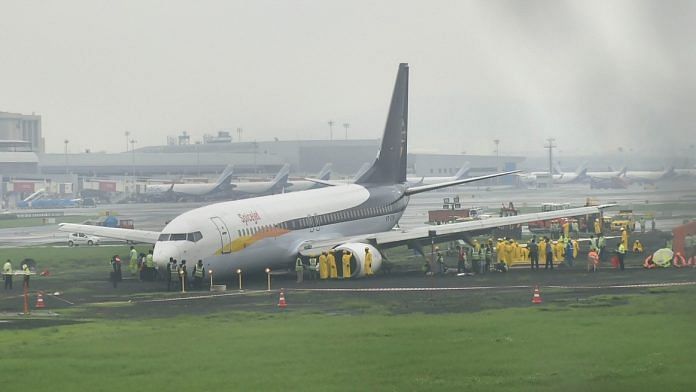New Delhi: Mechanical wear, contaminants such as rubber from plane tyres, and the impact of multiple take-offs and landings that cause a “polishing action” on the runway surface: These are some of the factors that have been identified in a DGCA audit as the major factors for eroding the friction or skid-resistance of runways, which puts aircraft and passengers at risk.
“Contaminants such as rubber deposits, jet fuel, oil spillage, moss, algae, water, snow, ice and slush, all cause friction loss on runway surfaces,” the Directorate General of Civil Aviation (DGCA) noted in a circular issued Tuesday evening.
“Heavy rubber deposits from the tyres can completely cover the pavement surface texture, causing aircraft braking capability and directional control particularly when runways are wet,” reads the order.
The audit report comes just a month after five Indian aircraft veered off runways within a span of three days, raising questions about the health of the country’s civil aviation operations.
The DGCA has stressed on conducting periodic ‘friction tests’ of runways to ensure any deterioration in conditions owing to different factors is nipped in the bud.
Also read: Do risk assessment during adverse weather conditions, aviation regulator DGCA tells airlines
When to be tested
DGCA Deputy Director General D.C. Sharma said the order clearly states the number of friction tests to be conducted at different airports: Once-a-year friction tests for airports handling less than 15 flights a day, and once-a-week for those handling over 200 flights a day.
“By adopting a systematic approach to the measurement of runway surface friction characteristics, the degradation of runway surface friction can be determined by the comparison and assessment of data over time,” DGCA Arun Kumar said in the order.
“By utilising this data, aerodrome operators should be in a position to target maintenance as required in order to ensure aircraft braking performance is optimised.”
The circular noted that the surface condition of a runway has major safety consequences for aircraft, especially on their landing performance.
“Thus when it is suspected that a runway has become slippery under other-than-normal wet conditions, or due to unusual surface conditions, additional friction measurement should be conducted by aerodrome operator,” the circular states. “Each runway end should be evaluated separately.”
Regular friction measurement enables an aerodrome operator to build up an overview of its condition over a period of time and identify deterioration. This enables runway maintenance to be planned and carried out in a timely manner.
Meanwhile, the DGCA has punished the pilots involved in the five run-off incidents, suspending them for six months to a year.
Also read: Inside story of why DGCA is conducting a safety audit of Indigo’s A320neo Airbus planes



